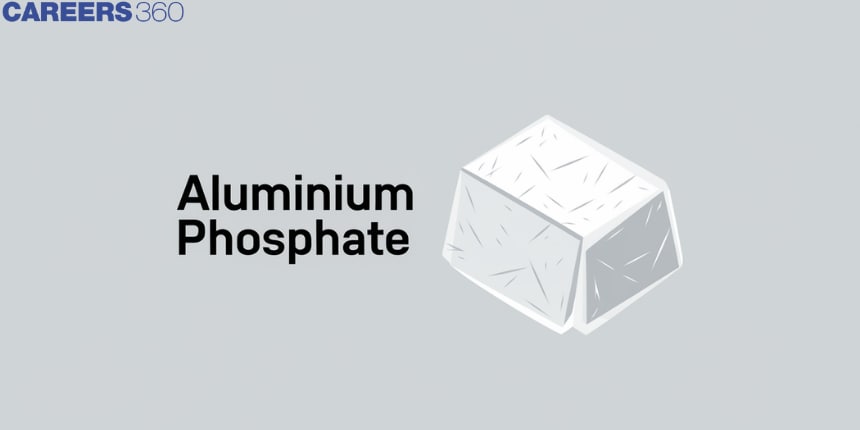Aluminium Phosphate: Properties, Structure, Applications, Health And Safety Hazards
Aluminium phosphate is prepared by exposing a soluble aluminium salt to alkaline conditions and contains aluminium orthophosphate hydrate of the formula AlPO4.
Properties Of Aluminium Phosphate(AlPO4)
AlPO4 is the molecular formula for aluminium phosphate. AlPO4
has a molecular weight of 121.9529 g/mol. The melting point of aluminium phosphate is 1800°C. Aluminium phosphate has a density of 2.57 g/cm³. The pH of aluminium phosphate is between 3.0 and 7.5. The smell is rotten. It is a form of white crystalline powder. Its complexity is 36.8 and it is insoluble in water.
NEET 2025: Mock Test Series | Syllabus | High Scoring Topics | PYQs
JEE Main: Study Materials | High Scoring Topics | Preparation Guide
JEE Main: Syllabus | Sample Papers | Mock Tests | PYQs
- Properties Of Aluminium Phosphate(AlPO4)
- Structure Of Aluminium Phosphate(AlPO4)
- Aluminium Phosphate(AlPO4) Chemistry
- Aluminium Phosphate(AlPO4) Applications
- Aluminium Phosphate(AlPO4) Health And Safety Hazards

Structure Of Aluminium Phosphate(AlPO4)
Aluminium phosphate generally exists as an anhydrous salt. However, its dihydrate and pentahydrate structures, represented as AlPO4.2H2O and AlPO4.5H2O, also occur. Aluminium phosphate compounds are formed by a phosphate anion and an aluminium cation. Its anhydrous salt structure is very similar to some other minerals such as quartz and has a trigonal crystal structure. However, its dihydrate has a structure similar to NaCl, with six cations coordinated with six anions.
Aluminium Phosphate(AlPO4) Chemistry
Aluminium phosphate reacts with hydrochloric acid to form phosphoric acid and aluminium trichloride.
Aluminium phosphate reacts with magnesium chloride and gives magnesium phosphate and aluminium trichloride as the product.
Aluminium Phosphate(AlPO4) Applications
Aluminium Phosphate tablets officially contain 500 mg per tablet of dry aluminium phosphate suitable for peppermint flavour.
Used as a beneficial antacid in patients experiencing significant loss of phosphate from aluminium salt.
Used in vaccine production as an additive to improve immunogenicity.
Aluminium phosphate carbonate gel was used in an aqueous suspension of hydroxy aluminium carbonate with orthophosphoric acid.
Due to its properties as a piezoelectric material, it is mainly used in the electronic and electrical industries.
It is also useful in making gums and adhesives. Additionally, it is the most commonly used antacid.
In industry it is used in ceramics, dental cements, cosmetics, paints, paper and pharmaceuticals.
Aluminium phosphate is the most common enhancer in vaccines, along with aluminium hydroxide.
Aluminium adjuvants are widely used with most antigens due to their low price and long history of efficacy. However, it is unclear how this salt acts as an adjuvant.
Aluminium phosphate is similar to aluminium hydroxide and is used to form AlCl3 to neutralise stomach acid (hydrochloric acid).
The gastrointestinal tract absorbs up to 20% of aluminium from ingested antacid salts – despite some unidentified concerns about the neurological effects of aluminium. It is said to be safe as an antacid under normal use, even during pregnancy and breastfeeding.
Aluminium phosphate can be used in combination or without other compounds that are white colourants such as pigments, corrosion inhibitors, cements and fillers.
Compound-related to it have similar uses. For example, Al(H2PO4)3 can be used in dental cements, metal coatings, glaze compositions, and refractory binders. Al(H2PO4)(HPO4), on the other hand, can be used in cements, adhesives and refractory binders.
Aluminium Phosphate(AlPO4) Health And Safety Hazards
- It is very dangerous from a health point of view.
- It can cause irritation to skin and mucous membranes.
- Coughing and wheezing can also be caused by its consumption.
- Respiratory system is damaged due to it.
- It is non-flammable.
Also Read
09 Dec'24 10:53 AM
30 Sep'24 11:36 AM
30 Sep'24 11:34 AM
30 Sep'24 11:34 AM
30 Sep'24 11:30 AM
30 Sep'24 10:59 AM